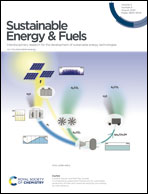Thermal input/output and operation characteristics of a chemical heat pump using the hydration reaction of calcium sulphate
Abstract
In this study, the cycle characteristics of a chemical heat pump for heat upgrading when exploiting a calcium sulphate (CaSO4) hydration reaction are determined. A CaSO4 0 and 0.5 hydration reaction system can be driven using a lower-temperature heat source under 403 K and can supply a heat output of 433 K. The volumetric average heat output and input of the reactor modules, as well as the coefficient of performance (COP) and hourly heat output, are measured. During the heat release and storage steps, the reactor for a plate heat exchanger with corrugated fins is set, and composite solidified CaSO4 reactantsare evaluated. From the experimental results, the maximum heat output and input of the reactor with slits are 1497 kW m−3 at 403 K and −1285 kW m−3 at 433 K. Based on the calculation of the COP and hourly heat output using this reactor module model, a maximum COP value of 0.57 is achieved for the heat upgrading cycle. An hourly heat output of 356.2 kW h m−3, with a heat recovery ratio of 0.4, heat release temperature of 423 K, and heat storage temperature of 413 K, is achieved. In addition, the heat upgrading cycle performance (hourly heat output and COP) affects the heat recovery and preparation times for switching the release and storage steps. Thus, the time management of cycle time is found to be an important parameter for the operation of the heat upgrading cycle.



 Please wait while we load your content...
Please wait while we load your content...